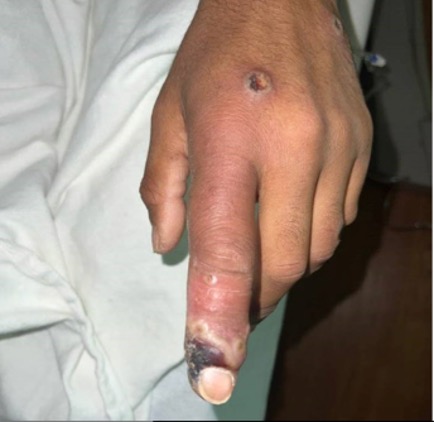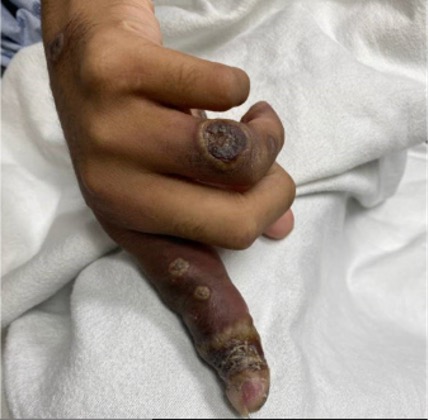Case Presentation: A 30 y/o man presented to the ED with complaints of unresolved monkeypox lesions. Along with this recent diagnosis of monkeypox with TPOXX treatment failure, he has a past medical history significant for advanced HIV/AIDS with CD4< 2 at admission on Bactrim prophylaxis, resolved Campylobacter infection, and chronic normocytic anemia. A month prior, he was admitted to an OSH with a painful rash on the face, back, chest, abdomen, and extremities and tested positive for monkeypox. He was readmitted weeks later for severe sepsis secondary to worsening monkeypox lesions and left index finger necrosis, suspicious for osteomyelitis on imaging. The patient was started on an experimental TPOXX treatment regimen, azithromycin, cefepime, vancomycin, and bactrim prophylaxis. CT scan showed multiple scattered pulmonary nodules. He was discharged on a 2-week course of ciprofloxacin, doxycycline, and teicoplanin. The patient presented to Froedtert for a third admission per recommendation of his PCP. He had significantly worsening monkeypox lesions in the left second digit, and new lesions of the mouth and face. He reported shortness of breath with ambulation along with cough, fevers, and chills. ID arranged communication with the CDC and Wisconsin Department of Health to obtain IV TPOXX as well as Vaccinia IVIG. Orthopedic surgery was consulted; no intervention done due to low CD4 count and overall hemodynamic stability during admission. At discharge, the patient’s lesions improved and overall CD4 count increased to 104 cells/uL. He had a follow up CT scan to further evaluate pulmonary nodules post-discharge which showed decreased size with near complete resolution of right anterior pleural thickening.
Discussion: Monkeypox is a viral zoonosis that belongs to the orthopoxvirus genus in the poxviridae family. Poxviruses range from critical smallpox to benign molluscum contagiosum. Monkeypox pathology is characterized by epithelial cells with prominent intracytoplasmic eosinophilic inclusions. Since May 2022, monkeypox cases have been reported in many countries where it is not already endemic. Inoculation of the virus to skin and mucosal surfaces can occur by direct contact, sexual or skin-to-skin, and may even include transmission via contaminated surfaces and materials. The majority of cases have been reported among men who have sex with men. Data suggests that nearly 40% of those diagnosed with monkeypox in the US also concurrently had HIV. Although it remains unclear whether pre-existing HIV diagnosis increases the likelihood of monkeypox infection with exposure, it has been established that those who are immunocompromised are at increased risk of developing severe monkeypox infection. The incubation period for monkeypox can vary widely from a few days up to five weeks. Patients typically present with generalized symptoms and lesions that may progress from simple macules/papules to vesicles and pustules that may ulcerate and crust prior to resolving. Severe monkeypox complications include pneumonia, encephalitis, and optic infections.
Conclusions: Here we present a case of osteomyelitis and pulmonary nodules secondary to disseminated monkeypox in the setting of end-stage HIV/AIDS with a CD4< 2. Early diagnosis of monkeypox in immunocompromised patients is essential in order to prevent cases such as ours that may progress quickly to various systemic manifestations. It is also extremely relevant to note the rarity and significance of viral osteomyelitis as well as pulmonary nodules in this patient.


